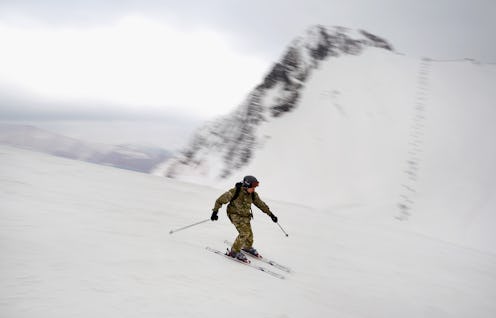
Winter sport lovers in parts of Russia and Eastern Europe were met with quite a surprise this weekend when they found that something was a little off about their usual stomping grounds. Photos of orange snow in Russia spread across social media, showing blanketed slopes that are usually a glistening white.
The cause, CNN reports, was a sandstorm in northern Africa that swept sand all the way into a southeastern region of Russia, tinting the snow a beige, yellowish hue. The strange weather phenomenon wasn't concentrated just in one place, either. Greece, Bulgaria, Ukraine, Romania, and Moldova have all reported similarly colored slopes.
Orange snow, caused by sand, occurs about every five years, the BBC reported, but the sand concentration has been particularly dense this time around. The reason for this is not immediately clear.
A spokesperson from the Sochi Center of Hydrometeorology and Monitoring of the Black and Azov Seas told the Daily Express that sand from the Sahara was probably swept up into the air before ultimately falling as rain on the other side of the Black Sea. On social media, witnesses described the orange, snowy landscape as Mars-like, and quipped that they felt like Martians while snowboarding and skiing over the orange-covered courses.
Not all instances of orange snow in Russia have been so easily explained, however, and sand isn't always necessarily the culprit. Back in 2007, a particularly odd bout of orange snow capture the world's attention. That time around, the phenomenon occurred in Siberia, a massive region in Russia that encompasses much of northern Asia known for its tundra and mountain ranges.
That time around, the orange color was said to feature a rotten smell, and was also oily to the touch, The Guardian reported at the time. Environmental agencies immediately scrambled to figure out whether or not the strange color, smell, and texture were a result of pollution from the regions large industrial economy. The area is also known for its oil and gas refineries, Reuters reported, but whether a specific industry or company was ever blamed for the event remained undetermined.
Initially, government officials said the strange coloring was a result of clay and sand blowing in from a storm in Kazakhstan, not unlike the sand blamed for the strange coloring this weekend. Environmental watchdogs were critical of this theory, however, given the strange texture and smell emanating from the discolored precipitation. Approximately 27,000 people reportedly lived in the affected area at the time, and the cause of the orange snow was never ultimately determined.
This time, however, skiers and snowboarders didn't appear to be as alarmed. Over the weekend, social media was filled with photos reportedly posted by visitors at a resort in Sochi, who, if their photos were any indication, continued to tear up the slopes, business as usual.
Photos showed crowds of people dressed in full snow gear, marveling at the rust colored sight before them. Just as many photos and videos showed visitors, some appearing to be very young children, sliding down mountain slopes like it was nothing at all.
It's no wonder that so many spectators described the snow as Mars-like, because very little white seemed to remain at all, giving the affected mountain ranges a distinctly sandy appearance. And, given that the phenomenon is reported to occur only once or twice a decade, it seemed to be truly a spectacle to behold.
The orange color isn't expected to stick around for very long, however. The Daily Mail reports that experts believe the snow will return to its normal whiteness after a few days. While the spectacle were temporary, skiers will probably remember this odd experience for years to come.